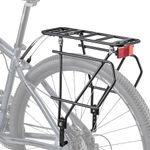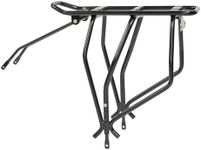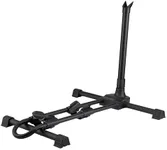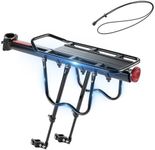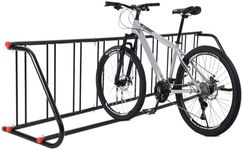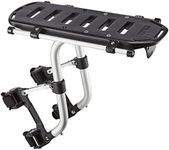Buying Guide for the Best Rear Bike Racks
Choosing the right rear bike rack can greatly enhance your cycling experience, whether you're commuting, touring, or just running errands. A rear bike rack allows you to carry extra gear, groceries, or even a child seat, making your bike more versatile and practical. To find the best fit for your needs, it's important to understand the key specifications and how they align with your intended use.Load CapacityLoad capacity refers to the maximum weight a rear bike rack can safely carry. This is crucial because overloading a rack can lead to damage or even accidents. Load capacities typically range from 20 to 70 pounds. For light commuting or carrying small items, a lower capacity rack (20-40 pounds) may suffice. For touring or carrying heavier loads, opt for a higher capacity rack (40-70 pounds). Consider what you plan to carry most often to determine the appropriate load capacity for your needs.
MaterialRear bike racks are commonly made from aluminum, steel, or a combination of both. Aluminum racks are lightweight and resistant to rust, making them ideal for everyday commuting and light loads. Steel racks are heavier but more durable and can handle heavier loads, making them suitable for touring and rougher conditions. If you need a balance of weight and strength, look for racks that combine both materials. Your choice should depend on how much weight you plan to carry and the type of riding you do.
Mounting SystemThe mounting system determines how the rack attaches to your bike. There are bolt-on racks that attach to eyelets on the bike frame, and quick-release racks that can be easily removed. Bolt-on racks are more secure and stable, making them ideal for heavy loads and long-distance touring. Quick-release racks offer convenience for those who need to frequently remove the rack, such as for switching between bikes or for storage. Consider how often you will need to remove the rack and the type of bike you have when choosing a mounting system.
CompatibilityCompatibility refers to how well the rack fits with your bike's frame and wheel size. Some racks are designed for specific types of bikes, such as road bikes, mountain bikes, or fat bikes. It's important to check the rack's specifications to ensure it fits your bike's frame size, wheel size, and brake type (disc or rim brakes). If you have a bike with disc brakes, look for racks specifically designed to accommodate them. Ensuring compatibility will prevent installation issues and ensure a secure fit.
Platform SizeThe platform size of a rear bike rack determines how much surface area you have for carrying items. Larger platforms provide more space for bulky items and can accommodate larger panniers or baskets. Smaller platforms are lighter and more streamlined, suitable for carrying smaller loads. If you plan to carry a variety of items or larger bags, opt for a rack with a larger platform. For minimalistic needs or lighter loads, a smaller platform may be sufficient.
Additional FeaturesSome rear bike racks come with additional features such as integrated fenders, spring clamps, or attachment points for lights and reflectors. Integrated fenders can help keep your gear clean and dry, while spring clamps can secure smaller items without the need for extra straps. Attachment points for lights and reflectors enhance visibility and safety. Consider which additional features might be beneficial for your specific needs and riding conditions.

